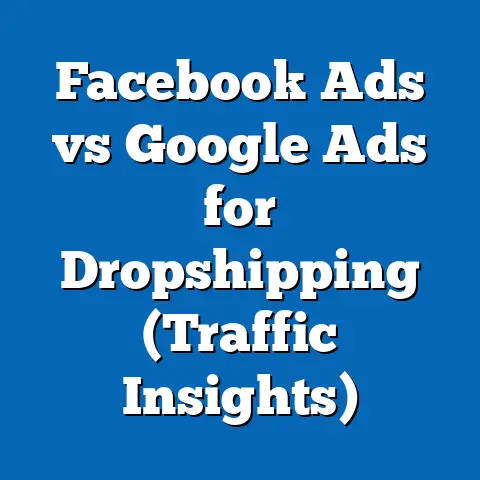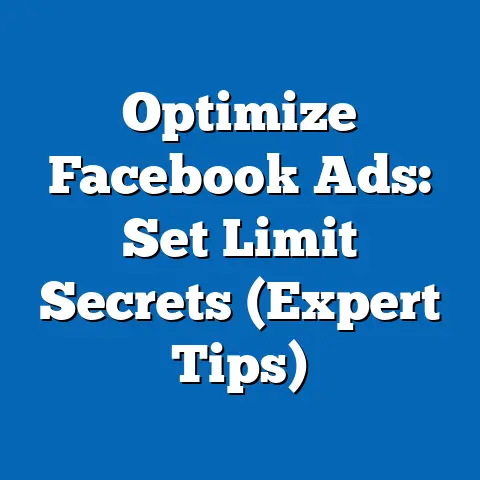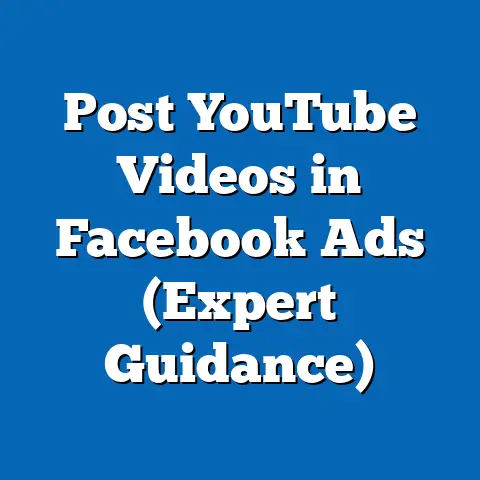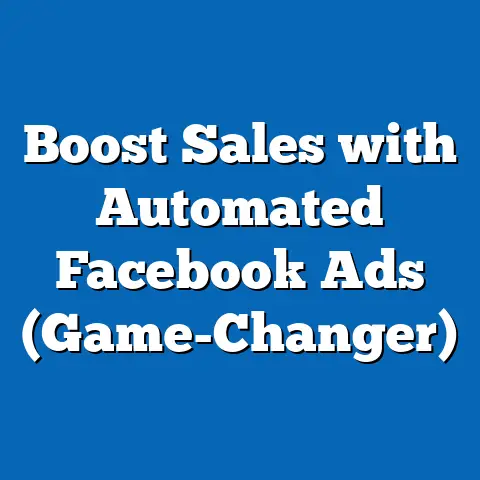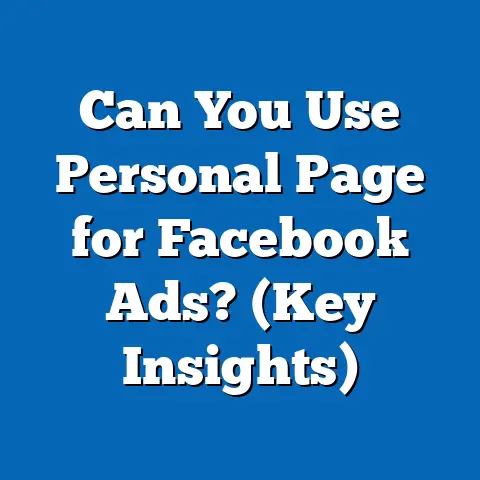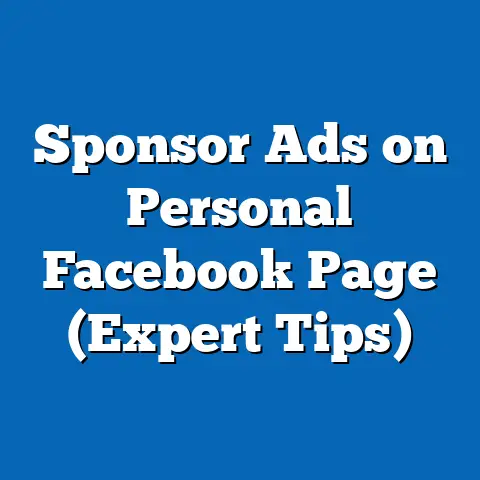Turn $1000/Day Facebook Ads into Profit Goldmines (Pro Proven Tips)
The world of advertising is a dynamic and ever-evolving landscape, but one thing remains constant: the pursuit of sustainable profitability. We’ve all heard the stories of overnight successes, but true, lasting success comes from building a foundation that can weather any storm. In today’s digital age, that foundation often lies in mastering the art of Facebook advertising.
I’ve spent years navigating the intricacies of Facebook Ads Manager, and I’ve seen firsthand how a well-executed strategy can transform a modest daily budget into a consistent revenue stream. But it’s not just about throwing money at the platform; it’s about understanding the ecosystem, targeting the right audience, crafting compelling creatives, and constantly optimizing for performance.
This isn’t just about making money; it’s about building a sustainable business. Think of it this way: a short-term win might feel good, but a long-term strategy that aligns with your values and resonates with your audience is what truly matters. We’re talking about building brand loyalty, making a positive impact, and creating a business that thrives for years to come.
So, how do you turn a $1000/day Facebook ad spend into a “profit goldmine”? What does that even mean? For me, it’s about achieving a consistently high return on ad spend (ROAS), building a loyal customer base, and creating a scalable business model that aligns with your values. It’s about more than just making money; it’s about creating a lasting impact.
Section 1: Understanding Facebook Ads
Before we dive into the specifics of maximizing your $1000/day budget, it’s crucial to understand the fundamentals of the Facebook advertising ecosystem. It’s like learning the rules of a game before you start playing – you need to know the basics to succeed.
Facebook’s advertising platform is incredibly powerful, offering a wide range of tools and features to reach your target audience. But with so many options, it can also be overwhelming. Let’s break down the key components:
-
Ad Types: Facebook offers a variety of ad formats to suit different objectives and creative styles. Some of the most popular include:
- Image Ads: Simple, visually appealing ads that showcase your product or service with a single image and accompanying text.
- Video Ads: Engaging ads that capture attention with motion and sound, ideal for storytelling and product demonstrations.
- Carousel Ads: Ads that display multiple images or videos in a scrollable format, perfect for showcasing a range of products or highlighting different features.
- Collection Ads: Ads that allow users to browse and purchase products directly within the Facebook app, ideal for e-commerce businesses.
- Lead Ads: Ads that collect user information through a built-in form, ideal for generating leads and building your email list.
-
Ad Placements: Where your ads appear on Facebook and its related platforms. Common placements include:
-
Facebook Feed: The most common placement, where ads appear alongside organic content in users’ news feeds.
- Instagram Feed: Ads that appear in users’ Instagram feeds, blending seamlessly with organic content.
- Facebook Stories: Short-form video or image ads that appear between users’ Stories.
- Instagram Stories: Similar to Facebook Stories, but on the Instagram platform.
- Facebook Marketplace: Ads that appear within the Facebook Marketplace, targeting users who are actively looking to buy or sell products.
- Audience Network: Ads that appear on third-party websites and apps that partner with Facebook.
-
Audience Targeting and Segmentation: This is where the magic truly happens. Facebook allows you to target your ads to specific groups of people based on their demographics, interests, behaviors, and more. The most important audience targeting options are:
- Custom Audiences: These are audiences you create based on your existing data, such as email lists, website visitors, or app users. This is powerful for retargeting.
- Lookalike Audiences: These are audiences that Facebook creates based on your Custom Audiences. Facebook finds people who share similar characteristics and behaviors with your existing customers, expanding your reach to a highly relevant audience. I’ve had tremendous success with Lookalike Audiences, finding new customers who are surprisingly similar to my existing ones.
- Demographic Targeting: Target users based on their age, gender, location, education, job title, and other demographic information.
- Interest Targeting: Target users based on their interests, hobbies, and the pages they like on Facebook.
- Behavioral Targeting: Target users based on their past online behavior, such as their purchase history, travel habits, or device usage.
-
Setting Clear Objectives: Before you even create your first ad, you need to define your goals. What do you want to achieve with your Facebook advertising? Common objectives include:
- Brand Awareness: Increase awareness of your brand and reach a wider audience.
- Reach: Show your ad to the maximum number of people within your target audience.
- Traffic: Drive traffic to your website or landing page.
- Engagement: Increase likes, comments, shares, and other forms of engagement on your ads and posts.
- Lead Generation: Collect leads through a built-in form or by driving traffic to a lead capture page.
- Conversions: Drive sales or other desired actions on your website or app.
It’s essential that these objectives tie into your sustainability goals. For example, if you’re promoting eco-friendly products, you might target users who are interested in sustainable living or environmental conservation.
Ad Types: Facebook offers a variety of ad formats to suit different objectives and creative styles. Some of the most popular include:
- Image Ads: Simple, visually appealing ads that showcase your product or service with a single image and accompanying text.
- Video Ads: Engaging ads that capture attention with motion and sound, ideal for storytelling and product demonstrations.
- Carousel Ads: Ads that display multiple images or videos in a scrollable format, perfect for showcasing a range of products or highlighting different features.
- Collection Ads: Ads that allow users to browse and purchase products directly within the Facebook app, ideal for e-commerce businesses.
- Lead Ads: Ads that collect user information through a built-in form, ideal for generating leads and building your email list.
-
Ad Placements: Where your ads appear on Facebook and its related platforms. Common placements include:
-
Facebook Feed: The most common placement, where ads appear alongside organic content in users’ news feeds.
- Instagram Feed: Ads that appear in users’ Instagram feeds, blending seamlessly with organic content.
- Facebook Stories: Short-form video or image ads that appear between users’ Stories.
- Instagram Stories: Similar to Facebook Stories, but on the Instagram platform.
- Facebook Marketplace: Ads that appear within the Facebook Marketplace, targeting users who are actively looking to buy or sell products.
- Audience Network: Ads that appear on third-party websites and apps that partner with Facebook.
Ad Placements: Where your ads appear on Facebook and its related platforms. Common placements include:
Facebook Feed: The most common placement, where ads appear alongside organic content in users’ news feeds.
Audience Targeting and Segmentation: This is where the magic truly happens. Facebook allows you to target your ads to specific groups of people based on their demographics, interests, behaviors, and more. The most important audience targeting options are:
- Custom Audiences: These are audiences you create based on your existing data, such as email lists, website visitors, or app users. This is powerful for retargeting.
- Lookalike Audiences: These are audiences that Facebook creates based on your Custom Audiences. Facebook finds people who share similar characteristics and behaviors with your existing customers, expanding your reach to a highly relevant audience. I’ve had tremendous success with Lookalike Audiences, finding new customers who are surprisingly similar to my existing ones.
- Demographic Targeting: Target users based on their age, gender, location, education, job title, and other demographic information.
- Interest Targeting: Target users based on their interests, hobbies, and the pages they like on Facebook.
- Behavioral Targeting: Target users based on their past online behavior, such as their purchase history, travel habits, or device usage.
Setting Clear Objectives: Before you even create your first ad, you need to define your goals. What do you want to achieve with your Facebook advertising? Common objectives include:
- Brand Awareness: Increase awareness of your brand and reach a wider audience.
- Reach: Show your ad to the maximum number of people within your target audience.
- Traffic: Drive traffic to your website or landing page.
- Engagement: Increase likes, comments, shares, and other forms of engagement on your ads and posts.
- Lead Generation: Collect leads through a built-in form or by driving traffic to a lead capture page.
- Conversions: Drive sales or other desired actions on your website or app.
It’s essential that these objectives tie into your sustainability goals. For example, if you’re promoting eco-friendly products, you might target users who are interested in sustainable living or environmental conservation.
Key Takeaway: Understanding the fundamentals of Facebook advertising is crucial for success. Familiarize yourself with the different ad types, placements, targeting options, and objectives before you start spending money. By laying a solid foundation, you’ll be well-positioned to maximize your ROI and turn your $1000/day budget into a profit goldmine.
Section 2: Setting Up Your $1000/Day Campaign
Now that you have a solid understanding of the Facebook advertising ecosystem, it’s time to dive into the practical steps of setting up your $1000/day campaign. This is where the rubber meets the road, and careful planning is essential to ensure you’re spending your money wisely.
-
Define Your Campaign Objectives: As we discussed earlier, your campaign objective should align with your overall business goals. Are you looking to generate leads, drive sales, or increase brand awareness? Choose the objective that best reflects your desired outcome.
-
Create Your Ad Sets: Ad sets are the containers for your ads. Within each ad set, you’ll define your target audience, budget, and ad schedule. This is where you’ll leverage the audience targeting options we discussed earlier, such as Custom Audiences, Lookalike Audiences, and demographic targeting.
-
Develop Your Ad Creatives: This is where you’ll create the actual ads that your target audience will see. Use compelling visuals, persuasive copy, and a clear call to action to grab their attention and encourage them to take the desired action.
-
Set Your Budget and Schedule: This is where you’ll allocate your $1000/day budget across your ad sets. You can choose between a daily budget or a lifetime budget. With a daily budget, Facebook will spend approximately $1000 each day. With a lifetime budget, you’ll set a total budget for the entire duration of your campaign.
-
Budget Allocation Strategies: How you allocate your $1000/day budget is critical for maximizing your impact. Here are a few strategies to consider:
- Even Distribution: Divide your budget equally across all of your ad sets. This is a good starting point if you’re unsure which ad sets will perform best.
- Performance-Based Allocation: Allocate more budget to the ad sets that are performing well and less budget to those that are underperforming. This allows you to focus your resources on what’s working.
- Targeted Allocation: Allocate more budget to ad sets that are targeting your most valuable audience segments. For example, if you know that customers who have previously purchased from you are more likely to convert, you might allocate a larger budget to your retargeting ad set.
-
-
A/B Testing and Optimization: This is an ongoing process of testing different ad creatives, targeting options, and budget allocations to see what performs best. A/B testing is an essential part of optimizing your campaigns for enhanced performance.
-
A/B Testing Strategies:
- Test Different Ad Creatives: Create multiple versions of your ads with different headlines, images, and calls to action. Run them simultaneously and see which ones generate the best results. I once ran an A/B test with two different images for the same ad. One image featured a product shot, while the other featured a lifestyle shot. The lifestyle shot outperformed the product shot by over 30%, demonstrating the power of emotional connection.
- Test Different Targeting Options: Experiment with different audience segments to see which ones are most responsive to your ads.
- Test Different Budget Allocations: Try allocating different budgets to your ad sets to see how it impacts performance.
-
Define Your Campaign Objectives: As we discussed earlier, your campaign objective should align with your overall business goals. Are you looking to generate leads, drive sales, or increase brand awareness? Choose the objective that best reflects your desired outcome.
Create Your Ad Sets: Ad sets are the containers for your ads. Within each ad set, you’ll define your target audience, budget, and ad schedule. This is where you’ll leverage the audience targeting options we discussed earlier, such as Custom Audiences, Lookalike Audiences, and demographic targeting.
Develop Your Ad Creatives: This is where you’ll create the actual ads that your target audience will see. Use compelling visuals, persuasive copy, and a clear call to action to grab their attention and encourage them to take the desired action.
Set Your Budget and Schedule: This is where you’ll allocate your $1000/day budget across your ad sets. You can choose between a daily budget or a lifetime budget. With a daily budget, Facebook will spend approximately $1000 each day. With a lifetime budget, you’ll set a total budget for the entire duration of your campaign.
-
Budget Allocation Strategies: How you allocate your $1000/day budget is critical for maximizing your impact. Here are a few strategies to consider:
- Even Distribution: Divide your budget equally across all of your ad sets. This is a good starting point if you’re unsure which ad sets will perform best.
- Performance-Based Allocation: Allocate more budget to the ad sets that are performing well and less budget to those that are underperforming. This allows you to focus your resources on what’s working.
- Targeted Allocation: Allocate more budget to ad sets that are targeting your most valuable audience segments. For example, if you know that customers who have previously purchased from you are more likely to convert, you might allocate a larger budget to your retargeting ad set.
Budget Allocation Strategies: How you allocate your $1000/day budget is critical for maximizing your impact. Here are a few strategies to consider:
- Even Distribution: Divide your budget equally across all of your ad sets. This is a good starting point if you’re unsure which ad sets will perform best.
- Performance-Based Allocation: Allocate more budget to the ad sets that are performing well and less budget to those that are underperforming. This allows you to focus your resources on what’s working.
- Targeted Allocation: Allocate more budget to ad sets that are targeting your most valuable audience segments. For example, if you know that customers who have previously purchased from you are more likely to convert, you might allocate a larger budget to your retargeting ad set.
A/B Testing and Optimization: This is an ongoing process of testing different ad creatives, targeting options, and budget allocations to see what performs best. A/B testing is an essential part of optimizing your campaigns for enhanced performance.
-
A/B Testing Strategies:
- Test Different Ad Creatives: Create multiple versions of your ads with different headlines, images, and calls to action. Run them simultaneously and see which ones generate the best results. I once ran an A/B test with two different images for the same ad. One image featured a product shot, while the other featured a lifestyle shot. The lifestyle shot outperformed the product shot by over 30%, demonstrating the power of emotional connection.
- Test Different Targeting Options: Experiment with different audience segments to see which ones are most responsive to your ads.
- Test Different Budget Allocations: Try allocating different budgets to your ad sets to see how it impacts performance.
A/B Testing Strategies:
- Test Different Ad Creatives: Create multiple versions of your ads with different headlines, images, and calls to action. Run them simultaneously and see which ones generate the best results. I once ran an A/B test with two different images for the same ad. One image featured a product shot, while the other featured a lifestyle shot. The lifestyle shot outperformed the product shot by over 30%, demonstrating the power of emotional connection.
- Test Different Targeting Options: Experiment with different audience segments to see which ones are most responsive to your ads.
- Test Different Budget Allocations: Try allocating different budgets to your ad sets to see how it impacts performance.
Key Takeaway: Setting up your $1000/day campaign requires careful planning and execution. Define your objectives, create targeted ad sets, develop compelling creatives, and allocate your budget strategically. Don’t forget to A/B test and optimize your campaigns continuously to maximize your ROI.
Section 3: Crafting Compelling Ad Creatives
Your ad creatives are the face of your campaign. They’re the first thing your target audience sees, and they play a crucial role in grabbing their attention and driving them to take action. In a world of endless scrolling, your ads need to stand out from the crowd and make a lasting impression.
-
Eye-Catching Visuals: Use high-quality images and videos that are visually appealing and relevant to your target audience. Make sure your visuals are optimized for mobile viewing, as most Facebook users access the platform on their smartphones.
- Visual Storytelling: Use visuals to tell a story and connect with your audience on an emotional level. Show them how your product or service can solve their problems or improve their lives. I’ve found that using user-generated content (UGC) can be incredibly effective. When real customers share their experiences with your product, it adds a layer of authenticity that resonates with potential buyers.
-
Persuasive Copy: Write clear, concise, and persuasive copy that highlights the benefits of your product or service. Use strong calls to action that encourage users to take the desired action.
- Benefit-Driven Headlines: Focus on the benefits, not just the features. How will your product or service make your customers’ lives better?
- Compelling Descriptions: Use persuasive language to describe the value of your offering. Highlight the unique selling points and address any potential objections.
- Clear Call to Action: Tell users exactly what you want them to do. Use action-oriented verbs like “Shop Now,” “Learn More,” or “Get Started.”
-
Storytelling in Ads: Stories are a powerful way to connect with your audience on an emotional level and convey your brand’s values. Share stories about your company’s mission, your customers’ experiences, or the impact you’re making on the world.
- Authenticity is Key: Be genuine and transparent in your storytelling. Don’t try to be something you’re not.
- Focus on the Human Element: People connect with stories about other people. Highlight the human element in your ads to create a stronger connection with your audience.
- Show, Don’t Tell: Use visuals and copy to show your audience what you’re all about, rather than just telling them.
-
Examples of Successful Ad Creatives: Let’s take a look at some real-world examples of ad creatives that have turned $1000/day into profitable returns.
-
Example 1: Sustainable Fashion Brand: A sustainable fashion brand ran a video ad showcasing their eco-friendly manufacturing process. The ad highlighted the brand’s commitment to ethical labor practices and environmentally friendly materials. The ad resonated with environmentally conscious consumers and drove a significant increase in sales.
- Key Learning: Highlight your commitment to sustainability in your ad creatives. Show your audience that you care about the planet and that you’re taking steps to make a positive impact.
-
Example 2: Plant-Based Food Company: A plant-based food company ran an image ad featuring a delicious-looking vegan burger. The ad copy highlighted the health benefits of plant-based eating and encouraged users to try their products. The ad targeted health-conscious consumers and drove a significant increase in website traffic and online orders.
- Key Learning: Focus on the benefits of your product or service. Show your audience how it can improve their lives.
-
Eye-Catching Visuals: Use high-quality images and videos that are visually appealing and relevant to your target audience. Make sure your visuals are optimized for mobile viewing, as most Facebook users access the platform on their smartphones.
- Visual Storytelling: Use visuals to tell a story and connect with your audience on an emotional level. Show them how your product or service can solve their problems or improve their lives. I’ve found that using user-generated content (UGC) can be incredibly effective. When real customers share their experiences with your product, it adds a layer of authenticity that resonates with potential buyers.
Persuasive Copy: Write clear, concise, and persuasive copy that highlights the benefits of your product or service. Use strong calls to action that encourage users to take the desired action.
- Benefit-Driven Headlines: Focus on the benefits, not just the features. How will your product or service make your customers’ lives better?
- Compelling Descriptions: Use persuasive language to describe the value of your offering. Highlight the unique selling points and address any potential objections.
- Clear Call to Action: Tell users exactly what you want them to do. Use action-oriented verbs like “Shop Now,” “Learn More,” or “Get Started.”
Storytelling in Ads: Stories are a powerful way to connect with your audience on an emotional level and convey your brand’s values. Share stories about your company’s mission, your customers’ experiences, or the impact you’re making on the world.
- Authenticity is Key: Be genuine and transparent in your storytelling. Don’t try to be something you’re not.
- Focus on the Human Element: People connect with stories about other people. Highlight the human element in your ads to create a stronger connection with your audience.
- Show, Don’t Tell: Use visuals and copy to show your audience what you’re all about, rather than just telling them.
Examples of Successful Ad Creatives: Let’s take a look at some real-world examples of ad creatives that have turned $1000/day into profitable returns.
-
Example 1: Sustainable Fashion Brand: A sustainable fashion brand ran a video ad showcasing their eco-friendly manufacturing process. The ad highlighted the brand’s commitment to ethical labor practices and environmentally friendly materials. The ad resonated with environmentally conscious consumers and drove a significant increase in sales.
- Key Learning: Highlight your commitment to sustainability in your ad creatives. Show your audience that you care about the planet and that you’re taking steps to make a positive impact.
-
Example 2: Plant-Based Food Company: A plant-based food company ran an image ad featuring a delicious-looking vegan burger. The ad copy highlighted the health benefits of plant-based eating and encouraged users to try their products. The ad targeted health-conscious consumers and drove a significant increase in website traffic and online orders.
- Key Learning: Focus on the benefits of your product or service. Show your audience how it can improve their lives.
Example 1: Sustainable Fashion Brand: A sustainable fashion brand ran a video ad showcasing their eco-friendly manufacturing process. The ad highlighted the brand’s commitment to ethical labor practices and environmentally friendly materials. The ad resonated with environmentally conscious consumers and drove a significant increase in sales.
- Key Learning: Highlight your commitment to sustainability in your ad creatives. Show your audience that you care about the planet and that you’re taking steps to make a positive impact.
Example 2: Plant-Based Food Company: A plant-based food company ran an image ad featuring a delicious-looking vegan burger. The ad copy highlighted the health benefits of plant-based eating and encouraged users to try their products. The ad targeted health-conscious consumers and drove a significant increase in website traffic and online orders.
- Key Learning: Focus on the benefits of your product or service. Show your audience how it can improve their lives.
Key Takeaway: Compelling ad creatives are essential for capturing your audience’s attention and driving them to take action. Use eye-catching visuals, persuasive copy, and storytelling to connect with your audience on an emotional level and convey your brand’s values.
Section 4: Analyzing and Optimizing Campaign Performance
Creating great ads is only half the battle. The other half is tracking your campaign performance and making adjustments to optimize your results. Without careful analysis and optimization, you’re essentially flying blind.
-
Key Performance Indicators (KPIs): These are the metrics you’ll use to track the success of your campaigns. Some of the most important KPIs include:
- Click-Through Rate (CTR): The percentage of people who see your ad and click on it. A high CTR indicates that your ad is relevant and engaging to your target audience.
- Cost Per Click (CPC): The amount you pay each time someone clicks on your ad. A low CPC indicates that your ads are efficient and cost-effective.
- Conversion Rate: The percentage of people who click on your ad and then take the desired action, such as making a purchase or filling out a lead form. A high conversion rate indicates that your landing page is effective and that your offer is compelling.
- Return on Ad Spend (ROAS): The amount of revenue you generate for every dollar you spend on advertising. A high ROAS indicates that your campaigns are profitable and that you’re getting a good return on your investment. This is the ultimate metric!
-
Facebook Ads Manager: This is your central hub for managing and analyzing your Facebook advertising campaigns. It provides a wealth of data and insights that you can use to optimize your results.
- Real-Time Monitoring: Use Facebook Ads Manager to monitor your campaign performance in real-time. Track your KPIs and identify any areas that need improvement.
- Data Visualization: Use the built-in data visualization tools to create charts and graphs that help you understand your campaign performance at a glance.
- Reporting: Generate detailed reports that provide insights into your campaign performance over time.
-
Strategies for Optimizing Campaigns: Based on your data analysis, you can make adjustments to your campaigns to improve their performance. Here are a few strategies to consider:
- Adjust Targeting: If your ads aren’t reaching the right people, adjust your targeting options to narrow your focus.
- Refine Ad Creatives: If your ads aren’t generating enough clicks or conversions, refine your ad creatives to make them more compelling.
- Optimize Landing Pages: If your ads are generating clicks but not conversions, optimize your landing pages to make them more user-friendly and persuasive.
- Adjust Budget Allocation: If some of your ad sets are performing better than others, adjust your budget allocation to focus your resources on what’s working.
Key Performance Indicators (KPIs): These are the metrics you’ll use to track the success of your campaigns. Some of the most important KPIs include:
- Click-Through Rate (CTR): The percentage of people who see your ad and click on it. A high CTR indicates that your ad is relevant and engaging to your target audience.
- Cost Per Click (CPC): The amount you pay each time someone clicks on your ad. A low CPC indicates that your ads are efficient and cost-effective.
- Conversion Rate: The percentage of people who click on your ad and then take the desired action, such as making a purchase or filling out a lead form. A high conversion rate indicates that your landing page is effective and that your offer is compelling.
- Return on Ad Spend (ROAS): The amount of revenue you generate for every dollar you spend on advertising. A high ROAS indicates that your campaigns are profitable and that you’re getting a good return on your investment. This is the ultimate metric!
Facebook Ads Manager: This is your central hub for managing and analyzing your Facebook advertising campaigns. It provides a wealth of data and insights that you can use to optimize your results.
- Real-Time Monitoring: Use Facebook Ads Manager to monitor your campaign performance in real-time. Track your KPIs and identify any areas that need improvement.
- Data Visualization: Use the built-in data visualization tools to create charts and graphs that help you understand your campaign performance at a glance.
- Reporting: Generate detailed reports that provide insights into your campaign performance over time.
Strategies for Optimizing Campaigns: Based on your data analysis, you can make adjustments to your campaigns to improve their performance. Here are a few strategies to consider:
- Adjust Targeting: If your ads aren’t reaching the right people, adjust your targeting options to narrow your focus.
- Refine Ad Creatives: If your ads aren’t generating enough clicks or conversions, refine your ad creatives to make them more compelling.
- Optimize Landing Pages: If your ads are generating clicks but not conversions, optimize your landing pages to make them more user-friendly and persuasive.
- Adjust Budget Allocation: If some of your ad sets are performing better than others, adjust your budget allocation to focus your resources on what’s working.
Key Takeaway: Analyzing and optimizing your campaign performance is crucial for maximizing your ROI. Track your KPIs, use Facebook Ads Manager to monitor your results, and make adjustments to your campaigns based on your data analysis.
Section 5: Scaling Your Campaigns for Long-Term Profitability
Once you’ve found a winning formula, it’s time to scale your campaigns for long-term profitability. This is where you can truly turn your $1000/day budget into a profit goldmine.
-
Scaling Strategies:
- Increase Budget: Gradually increase your budget on your best-performing ad sets. Monitor your KPIs closely to ensure that you’re still getting a good return on your investment.
- Expand Audience Reach: Use Lookalike Audiences to expand your reach to new customers who are similar to your existing ones.
- Leverage Retargeting: Retarget users who have previously interacted with your website or ads. Show them personalized ads that encourage them to take the next step. I’m a huge believer in retargeting. It’s like giving your potential customers a gentle nudge in the right direction.
- Diversify Ad Spend: Consider diversifying your ad spend across different platforms, such as Instagram and Messenger. This can help you reach a wider audience and maximize your engagement.
-
Maintaining a Sustainable Approach: As you scale your campaigns, it’s important to maintain a sustainable approach. This means ensuring that your growth doesn’t compromise your brand’s values or customer relationships.
- Focus on Customer Retention: Don’t just focus on acquiring new customers. Invest in customer retention strategies to build long-term loyalty.
- Provide Excellent Customer Service: Respond to customer inquiries promptly and professionally. Go above and beyond to exceed their expectations.
- Maintain Transparency: Be transparent about your business practices and your commitment to sustainability.
-
Insights on Diversifying Ad Spend: While Facebook is a powerful advertising platform, it’s not the only game in town. Consider diversifying your ad spend across different platforms to maximize your reach and engagement.
- Instagram: If your target audience is active on Instagram, consider running ads on the platform. Instagram is a great platform for visually appealing ads that showcase your products or services.
- Messenger: Use Messenger ads to engage with your customers in a more personal and conversational way. Messenger ads can be used to answer questions, provide support, or even make sales.
Scaling Strategies:
- Increase Budget: Gradually increase your budget on your best-performing ad sets. Monitor your KPIs closely to ensure that you’re still getting a good return on your investment.
- Expand Audience Reach: Use Lookalike Audiences to expand your reach to new customers who are similar to your existing ones.
- Leverage Retargeting: Retarget users who have previously interacted with your website or ads. Show them personalized ads that encourage them to take the next step. I’m a huge believer in retargeting. It’s like giving your potential customers a gentle nudge in the right direction.
- Diversify Ad Spend: Consider diversifying your ad spend across different platforms, such as Instagram and Messenger. This can help you reach a wider audience and maximize your engagement.
Maintaining a Sustainable Approach: As you scale your campaigns, it’s important to maintain a sustainable approach. This means ensuring that your growth doesn’t compromise your brand’s values or customer relationships.
- Focus on Customer Retention: Don’t just focus on acquiring new customers. Invest in customer retention strategies to build long-term loyalty.
- Provide Excellent Customer Service: Respond to customer inquiries promptly and professionally. Go above and beyond to exceed their expectations.
- Maintain Transparency: Be transparent about your business practices and your commitment to sustainability.
Insights on Diversifying Ad Spend: While Facebook is a powerful advertising platform, it’s not the only game in town. Consider diversifying your ad spend across different platforms to maximize your reach and engagement.
- Instagram: If your target audience is active on Instagram, consider running ads on the platform. Instagram is a great platform for visually appealing ads that showcase your products or services.
- Messenger: Use Messenger ads to engage with your customers in a more personal and conversational way. Messenger ads can be used to answer questions, provide support, or even make sales.
Key Takeaway: Scaling your campaigns for long-term profitability requires a strategic approach. Increase your budget, expand your audience reach, leverage retargeting, and diversify your ad spend. But most importantly, maintain a sustainable approach that aligns with your brand’s values and customer relationships.
Conclusion
Turning a $1000/day Facebook ad spend into a profit goldmine is not a pipe dream. It’s an achievable goal with the right strategies, a commitment to continuous optimization, and a focus on building a sustainable business.
We’ve covered a lot of ground in this guide, from understanding the Facebook advertising ecosystem to crafting compelling creatives, analyzing performance, and scaling your campaigns for long-term success. Remember, it’s not just about making money; it’s about building a brand that resonates with your audience, makes a positive impact, and thrives for years to come.
Sustainability is no longer a niche concept; it’s a core value that consumers are increasingly demanding. By integrating sustainability into your advertising strategy, you can attract a loyal customer base, build brand equity, and create a business that is both profitable and responsible.
Now it’s your turn. Take the tips and strategies I’ve shared in this guide and put them into practice. Experiment, test, and optimize until you find a winning formula that works for your business. And don’t be afraid to share your own success stories. Together, we can transform the world of Facebook advertising into a sustainable profit generator that benefits both businesses and society.
So, what are you waiting for? Go out there and turn your $1000/day Facebook ads into a profit goldmine! I’m excited to hear about your success.

